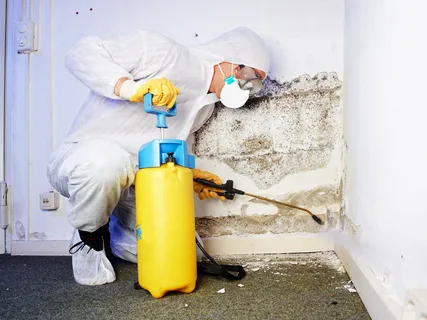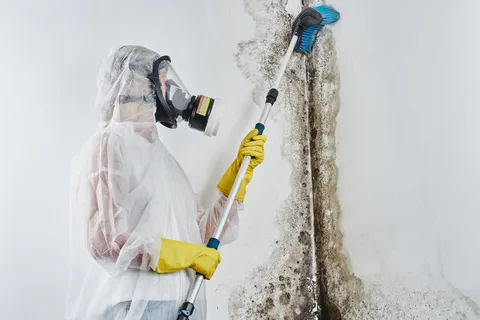Mold growth can be a silent and insidious threat to the health and well-being of individuals and families. Often hidden from view, mould can spread rapidly, releasing toxic spores into the air that can exacerbate respiratory issues, trigger allergies, and even cause serious health problems. Yet, despite its potential dangers, many people are unaware of the warning signs of mould infestation, and even fewer know how to inspect and remediate affected areas properly. In this comprehensive guide, we will delve into mould inspection report Sydney and remediation, providing you with the tools and knowledge you need to detect and eliminate mould growth in your home or workspace.
The Importance of Mold Inspections
When addressing mould issues, it’s crucial to start with a thorough understanding of the situation. Conducting a comprehensive mould inspection is the first step in clearing the fog, and it’s essential to get it right. A professional mould inspection is not just a matter of sending a technician to take a look around; rather, it is a meticulous process that involves identifying the source of the moisture, evaluating the extent of the mould growth, and analyzing the potential health risks associated with the infestation.
A skilled inspector will utilize advanced technology, such as thermal imaging cameras, moisture meters, and air sampling equipment, to gather data and identify potential mould growth sites. This information will then be used to create a detailed report outlining the findings, recommendations for remediation, and a plan for preventing future mould growth.
By investing in a thorough mould inspection, you’ll be able to gain a clear understanding of the situation and take the necessary steps to prevent mould growth from getting out of control. This is especially important in high-risk areas, such as homes with a history of water damage, poor ventilation, or chronic moisture issues. By clearing the fog, you can breathe easily, knowing that your home or office is safe and healthy.
How to Prepare For a Mold Inspection?
Preparing your space before embarking on a mould inspection is crucial to ensure a thorough and accurate assessment. This preparation is often overlooked, but it’s a critical step in mould remediation. Think of it as clearing the fog before the investigation begins. By taking the necessary steps, you’ll be able to identify potential mould issues, reduce the risk of contamination, and make the inspection process more efficient. Start by DE cluttering and organizing your space. Remove any unnecessary items, furniture, and personal belongings to give the inspector a clear path to inspect the affected areas.
This will also help to prevent any unnecessary disruption to your daily routine. Additionally, consider relocating sensitive equipment, such as computers or electronics, to a safe and mold-free area. Next, ensure that all areas to be inspected are easily accessible. This may involve removing carpeting, flooring, or other obstructions that could hinder inspection. It’s also essential to turn off any heating or cooling systems and any wet appliances to prevent further mold growth and contamination.
By taking the time to prepare your space, you can ensure a successful and effective mould inspection. Remember, a thorough inspection is the first step in addressing mould issues; proper preparation is key to achieving this goal.
 What to Expect During a Sydney Mould Inspection?
What to Expect During a Sydney Mould Inspection?
As you enter the room, the musty scent of dampness greets you, and the air is thick with an eerie haze. You can’t shake the feeling that something is off, and your instincts tell you that there’s more to this eerie atmosphere than meets the eye. That’s where a professional mould inspection comes in—a crucial step in uncovering the truth behind the mould air.
During a Sydney mould inspection, a trained and certified mould inspector will meticulously examine every nook and cranny of your property, from the walls and floors to the ceilings and crawlspaces. Armed with specialized equipment, including thermal imaging cameras and moisture meters, they’ll methodically search for signs of mould growth, tracking the source of the problem and identifying areas of potential contamination.
As they work, you’ll be given a detailed explanation of their findings, including photographs and diagrams to help illustrate the extent of the mould infestation. You’ll learn about the types of mould present, the moisture levels, and the potential health risks associated with the mould. This information will be essential in determining the best corrective action for remediation, ensuring that you take the necessary steps to eliminate the mould and prevent future growth.
Throughout the process, you’ll be treated with respect and transparency as your inspector educates you on the intricacies of mould and its impact on your property. With their expertise, you’ll be empowered to make informed decisions about the remediation process, and you’ll be one step closer to breathing easy, knowing that your home is safe and healthy once again.
How To Safely Contain And Remove Mold Growth?
The removal of mould growth requires the right equipment and techniques and a deep understanding of how to contain the mould to prevent its spread and re-growth safely. This is a crucial step in mould remediation, as it enables professionals to effectively remove the mould without putting occupants at risk of exposure to toxic spores. When containing mould growth, it’s essential to use specialized equipment, such as HEPA-filtered vacuum cleaners, to reduce the number of airborne mould spores. This equipment is designed to capture 99.97% of particles as small as 0.3 microns, including mould spores, to prevent them from spreading throughout the affected area.
In addition to using specialized equipment, professionals must also take steps to prevent the spread of mould by using containment barriers. These barriers are typically made of heavy-duty plastic sheeting and are designed in order to avoid mould spores from escaping the containment area. By sealing all openings and ensuring that the containment area is completely sealed, professionals can create a safe and controlled environment to remove the mould.
Throughout the process, it’s essential to prioritize safety and take precautions to prevent exposure to mould spores. This includes wearing personal protective equipment (PPE), such as gloves, masks, and eye protection, and ensuring that all equipment and supplies are properly cleaned and disinfected after each use. By following these guidelines, professionals can ensure that the mould is safely contained and removed and that the affected area is restored to a safe and healthy condition.
The Role of Personal Protective Equipment (PPE) In Mold Remediation
Regarding mould remediation, personal protective equipment (PPE) plays a crucial role in ensuring the safety and well-being of the remediation team and the affected individuals. Think of PPE as the unsung hero of the mould remediation process, working tirelessly behind the scenes to prevent exposure to harmful mould spores and other contaminants. The right PPE can differentiate between a successful remediation and a potentially disastrous situation. Choosing the correct equipment for the job is essential, considering the type of mould, the level of contamination, and the specific tasks involved in the remediation process.
From gloves and masks to goggles and respirators, each piece of PPE is carefully selected to provide maximum protection against the risks associated with mould remediation. In addition to physical protection, PPE also serves as a psychological barrier, allowing remediation professionals to work in otherwise overwhelming or intimidating environments. By providing a sense of security and confidence, PPE enables teams to focus on the task at hand, knowing they’re equipped to handle any situation.
In mould remediation, PPE is not just a necessity but a vital component of a comprehensive approach to mitigating the risks associated with mould growth. By understanding the importance of PPE and using it effectively, professionals can ensure that their work is done efficiently, safely, and with the utmost care for the health and well-being of all individuals involved.
The Benefits of Hiring a Professional Mold Remediation Company
When tackling a mould infestation, it’s easy to be overwhelmed by the sheer scope of the task. The fog of uncertainty can be daunting, making it difficult to know where to start or what steps to take next. This is where hiring a professional mould remediation company can be a game-changer. Unlike amateur attempts to tackle the problem, a professional mould remediation company brings a wealth of experience, expertise, and specialized equipment to ensure that the mould is safely and effectively removed.
Professionals possess the necessary training and certifications to safely handle mould remediation and have the knowledge and resources to identify and address the underlying causes of mould growth. This means that the problem is treated and prevented from reoccurring in the future. With a professional mould remediation company, you can trust that the job will be done correctly, efficiently, and with minimal disruption to your daily life.
In contrast, tackling the problem alone can lead to various potential issues, including further damage to your home or building, health risks, and even financial consequences. By hiring a professional, you can rest assured that the job is in capable hands and that you’ll be back to enjoying a safe and healthy living or working space in no time.
Conclusion
As you’ve navigated the complexities of mold inspections and remediation, we hope you’ve gained a deeper understanding of the importance of addressing these issues in your home or workspace. The consequences of neglecting mold can be severe, from damage to property and health to financial losses. With the comprehensive guide provided in this article, you now have the knowledge to take proactive steps in detecting and eliminating mold, restoring peace of mind and a safe environment. Whether you’re a homeowner, business owner, or simply a concerned individual, we empower you to take control of the situation and breathe easy, knowing you’ve taken the right steps to clear the fog of uncertainty.
FAQs
What information is included in a mould inspection report Sydney?
A mould inspection report sydney typically includes a detailed assessment of the areas inspected, findings of visible mould growth, and the results of any air or surface samples taken. It outlines the types and concentrations of mould detected, the locations affected, and the likely sources of moisture contributing to mould growth. The report also includes photographs, diagrams, and recommendations for mould remediation and moisture control measures to prevent future mould issues.
How can I use a mould inspection report?
You can use a mould inspection report to understand the extent and severity of mould problems in your property. It provides a basis for developing a remediation plan and can be shared with professional mould removal services to ensure effective treatment. The report can also be useful for real estate transactions, as it provides documented evidence of mould conditions and necessary corrective actions. Additionally, it can help in negotiating repairs or adjustments in property sales or rental agreements.
How long does it take to receive a mould inspection report?
The time frame for receiving a mould inspection report varies but typically ranges from a few days to a week after the inspection. This allows time for laboratory analysis of any samples taken and for the inspector to compile a comprehensive and accurate report. Some companies may offer expedited services for an additional fee if you need the report sooner. Always confirm the expected delivery time with your inspection service provider.
| Other Good Articles to Read |
| skank blogs |
| unreal blogs |
| tba blogs |
| all city forums |
| dany blogs |
| the music blogs |
| key forums |
| the big blog theory |
| joe blogs |
| blogs 4 me |
| Blogs Emon |
| Related Business Listings |
| Contact Directory |
| Local Business Profiles |



